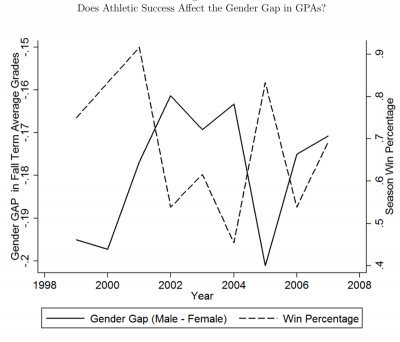 EUGENE, Ore. -- (Dec. 20, 2011) -- College football bowl season is in prime time, and a new report card is in: Male grades drop relative to female grades when their college football team performs well during the regular season.
EUGENE, Ore. -- (Dec. 20, 2011) -- College football bowl season is in prime time, and a new report card is in: Male grades drop relative to female grades when their college football team performs well during the regular season.
Male college students who don't participate in sports -- report a three-member team of University of Oregon economists -- get caught up in the excitement of their teams' winning and "are more likely than females to increase alcohol consumption, decrease studying and increase partying in response to the success of the team."
The study looked at students' grade data at the University of Oregon from 1999 through 2007, covering nine seasons when the football program was rising but inconsistent. The Ducks were 76-35 during those years, including a 4-3 record in post-season bowl appearances. That's a winning percentage of 68 percent.
 Female students aren't necessarily off the hook, said Jason M. Lindo, co-author of the study, which was published this month in the "Working Paper Series," a publication of the National Bureau of Economic Research that is circulated for discussion purposes and not peer-reviewed. (Download a PDF of the paper "Are Big-Time Sports a Threat to Student Achievement?")
Female students aren't necessarily off the hook, said Jason M. Lindo, co-author of the study, which was published this month in the "Working Paper Series," a publication of the National Bureau of Economic Research that is circulated for discussion purposes and not peer-reviewed. (Download a PDF of the paper "Are Big-Time Sports a Threat to Student Achievement?")
The data did not reveal declines in the grade-point averages (GPAs) of women, who did acknowledge drinking and partying more, but not at the pace of men, Lindo said. It appeared, he added, that the practice of curving grades in the classrooms probably masked any declines in women's performance. As males' classroom performance dipped, grading curves declined, too.
"In short, the effects that we identify on GPAs are relatively small," Lindo said. "Three fewer wins per season [based on a 60-percent winning season] shrinks the gender gap in GPAs, which favors females, by about 8 percent. That being said, we think that this finding really understates the effects on learning. Suppose all students were affected equally by the performance of the football team. If that were to happen, then we would see no impact at all on GPAs if all the professors were grading on a curve."
AUDIO CLIPS from Jason Lindo:
In general, men's GPAs tend to run .18 below those of women, researchers noted. Based on the Ducks' winning percentages each season, the gaps between men and women were evident. Less wins and less hoopla meant higher grades for men. In 2002, 2004, and 2006, when the Ducks were 7-6, 5-6 and 7-6, respectively, the gender gaps were small. In 2001 and 2005, when the Ducks were 11-1 and 10-2, respectively, the gaps widened.
These gaps coincided with acknowledged student behaviors. Following a win, men reported drinking and partying more, studying less and missing more classes than when the team loses. The same trends, but at lower levels, were followed by women, except they maintained their usual time studying.
The findings, researchers say, raise questions about the impact of big-time collegiate sports in terms of subsidies paid through public funds and tuition dollars funneled into athletic departments. The researchers say that the findings call for deeper studies on the cost effects of high-octane sports on academics and should not be taken as a condemnation of college athletics.
In 2010, researchers noted, 211 of 218 Division 1 university athletics departments that are subject to open-records laws received subsidies that averaged $9 million each. Subsidies were calculated using revenue categories that include student fees, direct and indirect institutional support and direct state support.
"There are important costs that policymakers need to consider when they think about the funds that are being directed toward big-time sports," Lindo said. "There are costs in terms of the academic mission of universities. We wouldn't go as far as to say big-time sports are bad. There certainly are lots of benefits. Students certainly enjoy them. Communities certainly enjoy them. But when we are thinking about spending in this area, we have to take these costs into consideration."
The Ducks in the 2008-2011 seasons have won 42, or 82 percent, of 51 games. They are 1-2 in bowl appearances. Winners of this season's first Pac 12 Championship game, the Ducks play the University of Wisconsin Badgers in the Rose Bowl on Jan. 2. Lindo said that he hopes to track GPA data from these seasons in a later study.
Co-authors with Lindo on the study were doctoral student Isaac D. Swensen and Glen R. Waddell, professor of economics.
About the University of Oregon
The University of Oregon is among the 108 institutions chosen from 4,633 U.S. universities for top-tier designation of "Very High Research Activity" in the 2010 Carnegie Classification of Institutions of Higher Education. The UO also is one of two Pacific Northwest members of the Association of American Universities.
Media Contact: Jim Barlow, director of science and research communications, 541-346-3481, jebarlow@uoregon.edu
Source: Jason M. Lindo, assistant professor of economics, 541-316-8343, jlindo@uoregon.edu